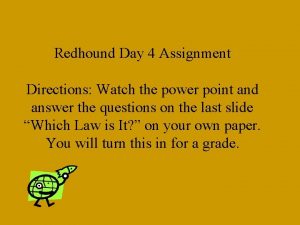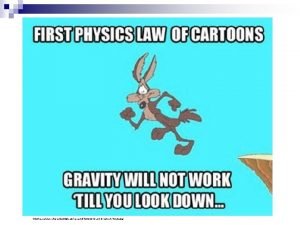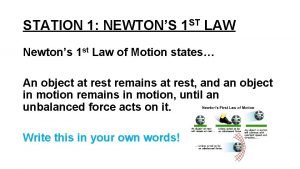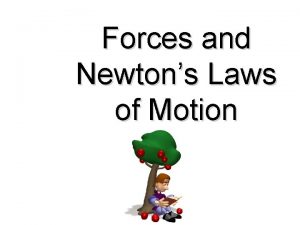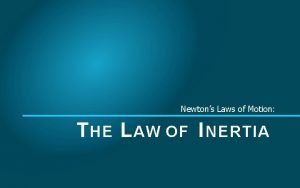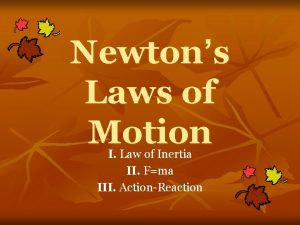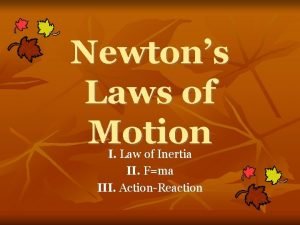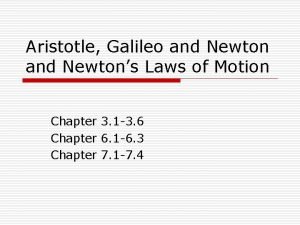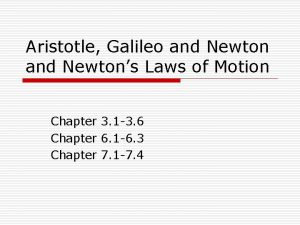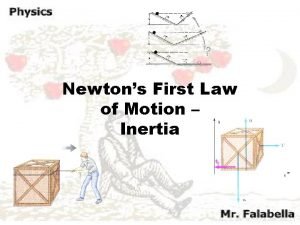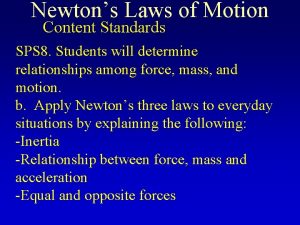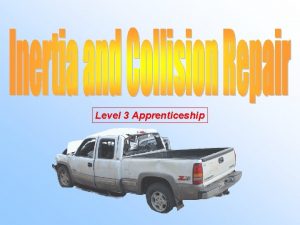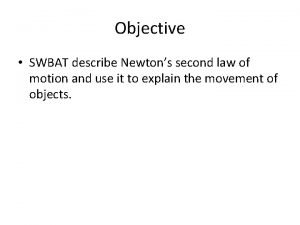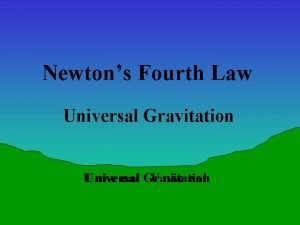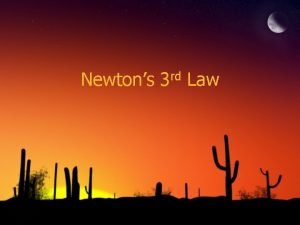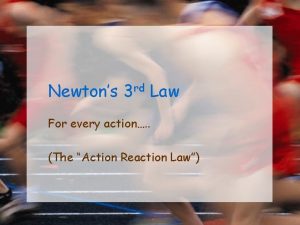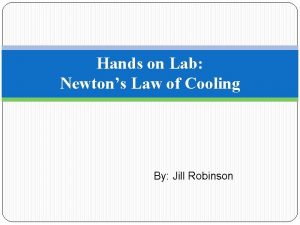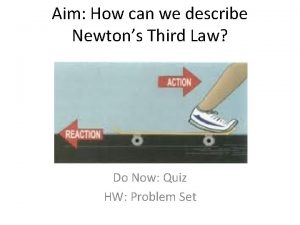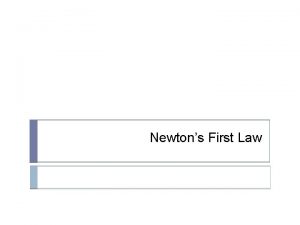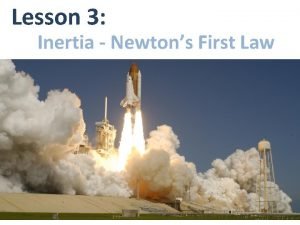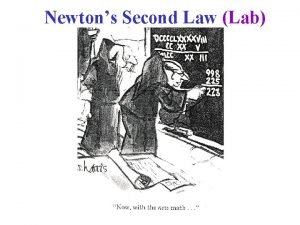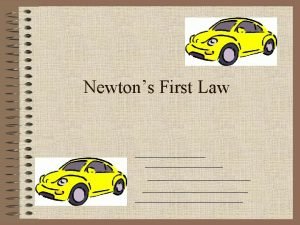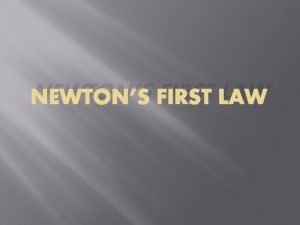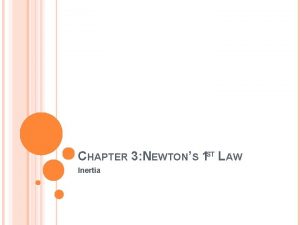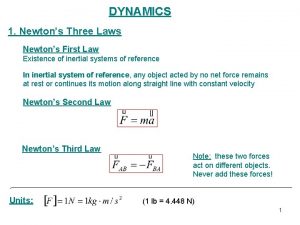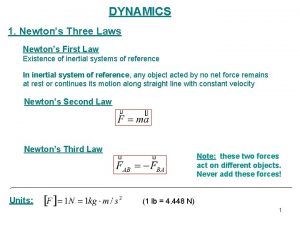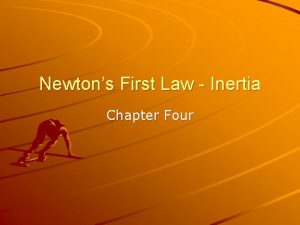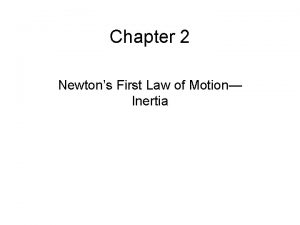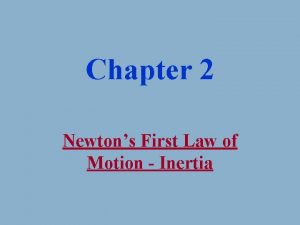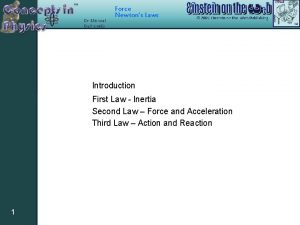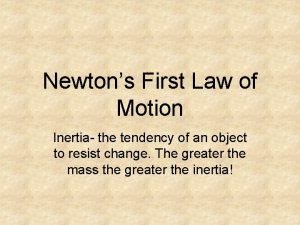NEWTONS FIRST LAW Law of Inertia Newtons three
































- Slides: 32

NEWTON’S FIRST LAW Law of Inertia

Newton's three laws of motion Isaac Newton 17 th century scientist Proposed a variety of laws that explain why objects move or don't move � Law of Inertia � Law of Acceleration � Law of Reciprocal Action

Newton’s First Law An object at rest stays at rest and an object in motion stays in motion unless acted upon by an unbalanced force

Newton’s First Law Also called the Law of Inertia is an object’s resistance to change its motion � Examples: To dislodge ketchup from the bottom of a ketchup bottle, it is often quickly shook downward and then suddenly stopped Headrests are placed in cars to prevent whiplash injuries during rear-end collisions While riding a skateboard (or bike) you fly forward off the board when hitting an object that abruptly stops the motion of the skateboard


Inertia Mass depends solely upon inertia The more inertia an object has, the more mass that it has If you have two bricks that look identical and no scale, how can you tell which one has more mass?

Forces There are four fundamental (basic) forces 1. 2. 3. 4. Strong Nuclear – holds the nucleus of atoms together Electromagnetic – between charges and magnetic fields Weak Nuclear – causes nuclear decay/radioactivity Gravitational – causes objects with mass to attract to each other These are all non-contact forces

Other Types of Forces Frictional – exerted by a surface as an object moves across it or tries to Tension – transmitted through a string, rope, cable or wire when it is pulled tight by forces acting from opposite ends Normal – support force exerted upon an object that is in contact with another stable object Air Resistance – frictional force caused by air Applied – exerted on an object by a person or another object Spring – exerted by a compressed or stretched spring upon any object that is attached to it

Types of Forces Type of force Friction Weight Abb. Direction Ffrict Force parallel to surface, opposite of motion (usually left or right) Fnorm Perpendicular to and away from surface (usually up) Fgrav Straight to center of Earth (down) Applied Fapp Varies (usually left or right) Normal Air Resistance Fair Opposite gravity in freefall (usually down) The unit of measurement force is the Newton (N)

Balanced vs. Unbalanced Forces Balanced = 0 Net Force Unbalanced ≠ 0 Net Force

Net Force The vector sum of all the forces acting on an object � Opposite directions cancel out (up and down, left and right) Free body diagrams make determining the net force easy � Shows the relative magnitude and direction of all forces acting upon an object in a given situation

Common Free Body Diagram

What is the Net Force? These are BALANCED forces!

What is the Net Force?

What is the Net Force? These are UNBALANCED forces!

Review An object at rest stays at rest and an object in motion stays in motion unless acted upon by an unbalanced force Inertia is an object’s resistance to change its motion The more inertia an object has, the more mass that it has Forces are pushes or pulls acting on an object, there are many different types The Net force is the vector sum of all the forces acting on an object

NEWTON’S SECOND LAW NOTES Law of Acceleration

Newton’s Second Law According to Newton, an object will only accelerate if there is a net or unbalanced force acting upon it

Newton’s Second Law The acceleration (a) of an object is directly proportional to, and in the same direction as, the net force (Fnet) acting on the body, and inversely proportional to its mass (m). Forcenet a = -------Mass Fnet = ma

Fnet = ma Determine the accelerations that result when a 12 -N net force is applied to a 3 -kg object and then to a 6 -kg object. A net force of 15 N is exerted on an encyclopedia to cause it to accelerate at a rate of 5 m/s 2. Determine the mass of the encyclopedia.

Weight A similar equation is used to show weight (Force of Gravity) except we use “g” instead of “a” �Remember g is equal to 9. 8 m/s 2 Weight = mg Fgrav = mg

Practice Problem A rightward force is applied to a 6 -kg object to move it across a rough surface at constant velocity. The object encounters 15 N of frictional force. Use the diagram to determine the gravitational force, normal force, net force, and applied force. (Neglect air resistance. )

Free Fall In the diagrams below, free-body diagrams showing the forces acting upon an 85 -kg skydiver (equipment included) are shown. For each case, use the diagrams to determine the net force and acceleration of the skydiver at each instant in time.

Terminal Velocity As an object falls, it picks up speed. The increase in speed leads to an increase in the amount of air resistance. Eventually, the force of air resistance becomes large enough to balance the force of gravity. � Net force is 0 Newton; the object will stop accelerating. The object is said to have reached a terminal velocity.

Newton’s Second Law Summary

NEWTON’S THIRD LAW Law of Reciprocal Action

Newton’s Third Law For every action, there is an equal and opposite reaction.

Newton’s Third Law Also called the Law of Reciprocal Action (or Interactions) � Examples Boy pushes on wall, wall pushes on boy Bat pushes on ball, ball pushes on bat Foot pushes on ground, ground pushes on foot


Newton’s Third Law While driving down the road, a firefly strikes the windshield of a bus and makes a quite obvious mess in front of the face of the driver. This is a clear case of Newton's third law of motion. The firefly hit the bus and the bus hits the firefly. Which of the two forces is greater: the force on the firefly or the force on the bus?

Newton’s Third Law The force of the recoiling rifle is. . . � a. greater than the force of the bullet. � b. smaller than the force of the bullet. � c. the same size as the force of the bullet. The acceleration of the recoiling rifle is. . . � a. greater than the acceleration of the bullet. � b. smaller than the acceleration of the bullet. � c. the same size as the acceleration of the bullet.

Review http: //www. youtube. com/watch? v=UVdqx. Yy. FRKY First Law Second Law Third Law
 Newton's three laws
Newton's three laws 3 laws of newton
3 laws of newton Newton's first law of motion
Newton's first law of motion Newton's 1st law meme
Newton's 1st law meme Law of motion
Law of motion Facts about newtons first law
Facts about newtons first law Newtons first law pictures
Newtons first law pictures Newton's first law and second law and third law
Newton's first law and second law and third law Newton's first law
Newton's first law Newton’s law of action-reaction
Newton’s law of action-reaction Newtons first ;aw
Newtons first ;aw Newtons second lw
Newtons second lw Inertia in everyday life
Inertia in everyday life Law of inertia
Law of inertia Law of inertia pictures
Law of inertia pictures Law of force and acceleration
Law of force and acceleration A ball is rolled across a countertop
A ball is rolled across a countertop Aristotle galileo and newton ideas about motion
Aristotle galileo and newton ideas about motion Aristotle law of inertia
Aristotle law of inertia Examples of newton's first law
Examples of newton's first law Inertia meaning
Inertia meaning Newtons 3 rd law of motion
Newtons 3 rd law of motion Newton's second law in soccer
Newton's second law in soccer Describe newtons second law
Describe newtons second law Newton’s fourth law
Newton’s fourth law Newtons 3 rd law of motion
Newtons 3 rd law of motion Newton's 3 laws
Newton's 3 laws Newtons 3 rd law
Newtons 3 rd law Newtons 3 rd law
Newtons 3 rd law What is k in newtons law of cooling
What is k in newtons law of cooling Describe newtons third law
Describe newtons third law Newtons third law of thermodynamics
Newtons third law of thermodynamics Newtons 1law
Newtons 1law
